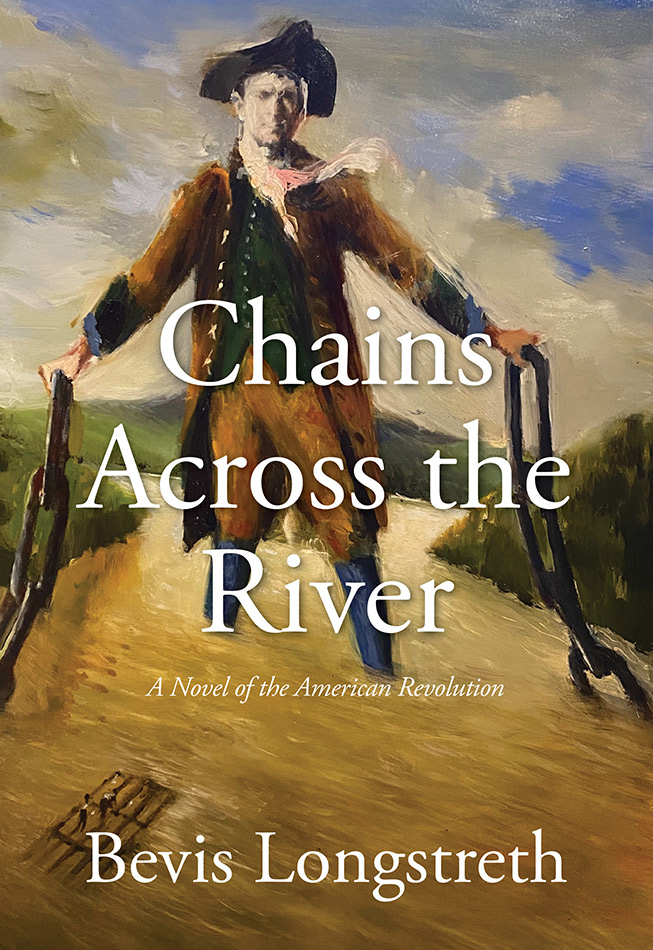
About Chains Across the River
In the Revolution, a British deserter could become a traitor to the Crown by joining the Continental Army and there become a hero. Chains Across the River tells the enthralling tale of one such soldier, Captain Thomas Machin, a brilliant engineer of flawed character born, educated and trained in England. He enlisted in the British Foot and was posted to Boston, where he saw action at Breed’s Hill before deserting to join the Continentals.
Observing Machin’s engineering skill and practical bent, Washington ordered Machin to the Hudson River, there to imagine, design and install obstructions to block the British Armada gathering in New York Harbor. Both sides believed control of the river a strategic necessity.
The immensity of Washington’s charge was matched by Machin’s audacity in imagining obstructions capable of stopping an 850-ton warship under full sail and following tide. He installed a chain at Fort Montgomery and, when the British overran that Fort and cut the chain, he installed another at West Point.
Filling out the story of Thomas Machin are the unforgettable women in his life, Elizabeth Van Horne and Caroline Filippante.
Why historians devote little attention to Machin is explained by what didn’t happen on the Hudson. The British cut the first chain without testing it and never sailed against the second. Washington and Machin understood the chain could deter without being tested. In these pages the known facts about Machin have been woven into an Homeric-like tale of daring, adventure, intrigue and triumph.
Praise for Chains Across the River
"Like the very chains that play a starring role in warding off the depredations of British ships, Longstreth’s novel deftly links the fascinating story of a tricky piece of engineering to a tale of the loves and woes and delights of some of the people who fought for American independence. A treacherous, rollicking, bone-raw colonial culture, which could so easily be lost to memory, bursts forth in these pages, as does a feel—underfoot, towering overhead—for the hazardous but seductively gorgeous lands surrounding the mighty Hudson River. Longstreth’s narrative brings to vivid life the scale of ingenuity, imagination, and daring required of the women and men who launched the courageous American experiment."
—Dominique Browning, Writer, Editor, Director of Moms Clean Air Force
"Longstreth’s Chains Across the River turns history of the American Revolution into compelling fiction. It tells a new and remarkable story of the chains strung across the Hudson to stop the British fleet from sailing upstream. A rewarding read."
— Timothy Wirth, Former Senator, Colorado
A crowded tapestry of a novel, reconstructing a critical moment in American Revolutionary history.
—Marie Winn, Author of, among others, The Plug-in Drug, Red-tails in Love and Central Park in the Dark
"Read Bevis Longstreth’s Chains Across the River not just to discover a history that you are unlikely to know, but to be moved by it. Longstreth reminds us what kinds of achievements are possible when hands, minds, and hearts come together in the name of values that are worth the fight. In a year as destabilizing and demoralizing as 2020, his reminder is a gift none of us should pass up.
—Karen Shepard, Author of, most recently, Kiss Me Someone
"In his latest novel, Chains Across the River, Bevis Longstreth has introduced readers to an almost forgotten part of the American Revolution—the attempt to build a chain across the Hudson River to block the British fleet's access to the north. Thomas Machin, a British engineer who deserted from the British to join the Americans, was the man put in charge of the project and Longstreth has set him at the center of a fascinating tale of war, love and betrayal as America fought to be free."
—Susan Carey, Book Critic and Editor